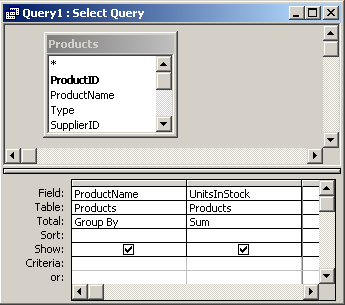Returns the sum of a set of values contained in a specified field on a query. Mit der Sum -Funktion werden die Werte in einem Feld summiert. The Sum function totals the values in a field.
Sie können mit der Sum -Funktion beispielsweise die Gesamtfrachtkosten ermitteln. For example, you could use the Sum function to determine the total cost of freight charges. Die Sum -Funktion ignoriert Datensätze, die null-Felder enthalten. SUM() function with group by. The aggregate functions summarize the table data.
Once the rows are divided into groups, the aggregate functions are applied in order to return just one value per group. It is better to identify each summary row by including the GROUP BY clause in the query resulst. You sum data by adding the Sum function to your query, you count data by using the Count function, and so on. It is used in conjunction with the Group By clause. You can use the Sum function in a query by clicking on the Totals button in the toolbar (This is the button with the summation symbol).
If I understand correctly, you need to change two things in your query. The first is to move the condition to the where clause. I would prefer to deal with it in SQL.
Browse other questions tagged sql ms- access or ask your own question. Access Query Total Sum between Dates. SUM () and COUNT() functions. I am trying to Sum a Value based upon the result set of a subquery.
Du kannst Beiträge in dieses Forum schreiben. I want to return the SUM of a field only if the sum is non-zero. Cette fonction ne fonction que sur des colonnes de types numériques (INT, FLOAT …) et n’additionne pas les valeurs NULL.
SELECT SUM returns the sum of the data values. I was of the understanding that access uses n instead of m for minutes because m is for month. I will need it to sum to over hours if required. Concretely, we take the sum of sales in the second table over every row that has a date less than or equal to the date coming from the first table. Add up the values in a query result set.
Syntax Sum (expression) Key expression A field or formula that evaluates to a numeric expression. Use the Sum function in the access query builder by clicking the Totals toolbar button: Σ. We will use the products table for our examples in the following sections. Relational databases are not spreadsheets. You will not find functions that operate on a set of columns. SQL SUM function examples.
Hallo Einsteinschen In der erste Spalte meiner Tabelle habe ich KW. Hallo, ich ver mich nun seit einiger Zeit an einem Problem. Anbei ein einfaches Beispiel für die Demonstation der COUNT()-Syntax in SQL.

Wir gehen wieder von vollgender vereinfachten Tabelle aus: Diesmal wollen wir die Anzahl der Horror-Bücher ermitteln. Demnach muss die Rubrik gezählt werden, wo die Rubrik gleich Horror ist. Im nachfolgenden Video Tutorial wird der Befehl GROUP BY anhand verschiedener Beispiele vorgestellt. Dieser Abschnitt erläutert die Verwendung von Aggregatfunktionen.
An often-overlooked feature of the ordinary select query is its ability to calculate totals. Whilst the crosstab query is useful for analysing complex data, it needs several fields to work with. Supposing the data you wish to analyse is contained in just two fields?

Something enabling me to fetch the Row_Number, Max, Min, Sum over a partition by special fields?
Keine Kommentare:
Kommentar veröffentlichen
Hinweis: Nur ein Mitglied dieses Blogs kann Kommentare posten.